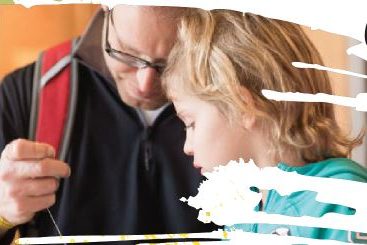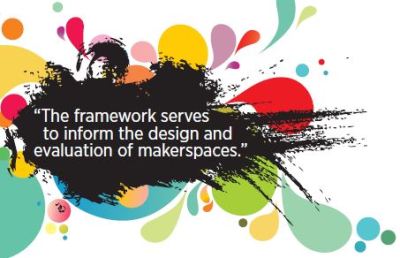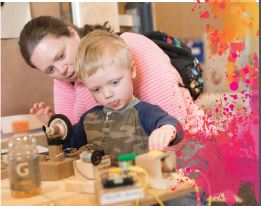
This article originally appeared in the September/October 2016 issue of Museum magazine.
Identifying the elements that create and foster conditions for optimal learning.
Makerspaces and maker-based learning experiences are settings and opportunities for participants to use real tools and materials to take apart, build, or adapt their own creations. Sometimes referred to as tinkering or a Fablab, making and makerspace are umbrella terms to indicate hands-on, learner-centered activities of production. Digital or analog, traditional or innovative, making can operate at the boundaries of different disciplines. In recent years, an increasing number of US museums have established or invested resources to implement maker programs or makerspaces for their visitors. These programs and spaces serve a variety of organizational and programmatic goals, but fundamentally, they serve as sites of learning. Yet, despite these growing efforts, the field knows relatively little about the best practices for maker-based learning experiences.

In 2014, the Institute of Museum and Library Services (IMLS) launched a cooperative agreement with the Children’s Museum of Pittsburgh to build the capacity of both museums and libraries to develop effective makerspaces. This also included a team of thought partners providing ongoing feedback. These thought partners included: Karen Wilkinson and Mike Petrich from the Tinkering Studio in the Exploratorium in San Francisco, Andrea Saenz from the Chicago Public Library, Adam Rogers from the North Carolina State University Libraries, and Lisa Regalla from the Maker Education Initiative (Maker Ed).
After gathering information through more than 50 site visits and interviews with museum and library professionals across the country, the project team developed a framework to optimize learning in library and museum makerspaces. The framework consists of three elements: Purpose, People, and Pieces and Parts. By carefully considering each of these elements, museums can foster the ideal conditions for learning to unfold within maker-based experiences.
The framework is intended to guide practitioners’ planning and implementation of makerspaces and programs—not to dictate how they should develop and implement them. As we learned by visiting sites countrywide, there are many different ways to offer productive maker-based learning experiences. Instead of prescribing a fixed methodology, the framework aims to encourage critical discussion and consideration of key aspects of these experiences. In the spirit of making, this framework is meant to be flexible and adaptable to serve each museum or library’s concerns, priorities, and conditions.
Framework Element: Purpose
Libraries and museums can choose to present a wide variety of traditional, innovative, and potentially effective learning experiences. What is it about the making or the makerspace that helps it achieve the institution’s goals? This is the overarching question underlying the Purpose element of the framework.
For a learning experience to be successful, a museum must identify its purpose with respect to its institutional goals, mission and affiliations, programmatic strengths, and values. Through our site visits for this project, we noted that there are a broad range of goals that a library or museum makerspace might hope to achieve, including: cultivating 21st-century skills such as critical thinking, creativity, communication, and collaboration, supporting workforce development and economic vitality, assisting with college and career readiness and awareness, supporting science, technology, engineering, and mathematics (STEM) or science, technology, engineering, art, and mathematics (STEAM) learning, seeding entrepreneurship, nurturing dispositional qualities such as persistence, resilience, passion, and self-efficacy, engaging visitors in a positive, social, and creative atmosphere.
This is certainly not a comprehensive list, and all of these goals are valid and potentially appropriate for a particular museum or library. However, the kinds of tools and materials needed for a space and the role that people (educators, facilitators, staff, etc.) play in facilitating maker experiences could change significantly depending on which goal is identified. Mike Cook from the Betty Brinn Children’s Museum in Milwaukee noted that one goal for its makerspace, called Be a Maker, was to connect learners with the city’s industrial heritage. While it is not the space’s
only goal, this focus has had implications on the tools that staff choose, the activities they support, and the space’s design: a huge, historic clock inhabits a prominent corner of Be a Maker.
The Purpose element of the framework also addresses the extent to which a program or space may target a specific audience. For certain institutions—such as a typical children’s museum, where families with young children are a dominant audience—this might be easy to deduce. But for many museums, audience may be a point of explicit consideration. The values and goals a museum identifies for a makerspace may affect its target audience. For example, equipment safety might be an issue for young children, whereas a space with a focus on workforce development might be more appropriate for teens or adults.
Finally, identifying the metrics of success for a maker experience is key to evaluating the program’s impact. Defining success can be challenging, however, since traditional metrics may be inadequate for a makerspace. For example, basing success on the number of participants in a program may not be sensible, as many maker programs place a greater emphasis on depth of experience than on the number of attendees. The more participants a program has, the more pressure is on the facilitator, which may lead to a shallower learning experience.
Framework Element: People
Even though people often equate makerspaces with colorful walls or fancy equipment, practitioners share a hard-earned, open secret: people and facilitation strategies are quintessential to most maker-based learning experiences in museums and libraries. The importance of people to these experiences cannot be underestimated. Ideally, people design or adapt activities beforehand. During the experiences, facilitators demonstrate, ask and answer questions, provide feedback and encouragement, and connect learners to resources to support their projects. Afterward, facilitators reflect on the activity, document its products, and clean up and organize the space so it’s ready for the next experience.
Central to the role of people is the staffing structure. Some museums and libraries create new positions, such as a program manager who takes on a leadership role with the space and accompanying activities. Others reallocate responsibilities so that existing staff facilitate maker experiences in addition to their regular duties. Of course, many institutions are unable to hire new people or to reallocate time. Instead, some museums have had success by utilizing volunteers, college work-study students, interns, and even children to support maker-based experiences. Keith Braafladt, director of the Learning Technologies Center at the Science Museum of Minnesota leverages a team of volunteers to facilitate maker-based learning experiences throughout the museum. The important point is that the staffing of maker-based learning experiences is an essential part of their design.
Finally, the People element considers the model of facilitation for the makerspace. How does the facilitation help a learner engage in the marker-based experience? For some institutions, facilitation entails a staff member learning alongside participants. For others, facilitation involves an interactive discussion with learners while they are engaged in making. For others still, facilitation includes inserting signs or resources into the space to support learners’ creative process. Ultimately, facilitation should mean that people are working toward a particular goal for the experience.
The Arkansas Discovery Network is a group of museums connected through a hub at the Arkansas Discovery Museum in Little Rock. Kathleen Lawson, director of the network, told us that it offers professional development workshops for staff interested in creating tinkering spaces. The goal is to encourage member museums to take a thoughtful stance toward facilitation. During professional development meetings, museum staff have checked off the archetypical tinkering activities, such as Makey Makey—an invention kit that connects everyday objects to computer programs—and automata—mechanical devices often made from simple materials like cardboard. The thrust of these sessions, however, is not only how to use the particular tools but how to use them in the service of learning. For example, cardboard automata can make a learner aware of different mechanisms of motion that they might see and use in their everyday life.
Framework Element: Pieces and Parts
Pieces and Parts is our collective term for the tools, materials, and equipment that enable staff and visitors to work on projects in a makerspace. The framework suggests that the pieces and parts should align with and serve the space’s purpose and people. Only after a museum or library has identified the overarching goals for its makerspace and the people to support those goals should it consider the tools, materials, and equipment that will best facilitate
those objectives.
A goal of fostering creative expression, for example, may be accomplished with a wide variety of materials, such as cardboard, wires, wood, recycled materials, and textiles. If the goal is to support workforce development, then the pieces and parts should engender specific skills and mindsets valued by the field of interest. Such skills may include persistence, collaboration, and goal setting, as well as proficiency with related tools or equipment.
Ideally, the pieces and parts also should align with the skills, capacity, and interests of the people who manage the space. For example, if facilitators are highly skilled computer programmers, then activities could include tools and materials that facilitators would use to help learners practice coding, such as laptops or micro-controller kits. A goal of this program or space might be to increase learners’ technological fluency in general or with a particular end in mind, such as using computer programming for creative problem-solving.
Another important component of pieces and parts is the architecture of the makerspace. Learning happens in a physical context, whether it is a permanent, dedicated space or a temporary space that is transformed as needed. The design of a physical context for making communicates the intentions for the learning experiences within.

David Wells, director of maker programming at the New York Hall of Science, noted that their maker programs have a strong focus on design. For their learners, making is not only about producing a product. Making encompasses a design process that includes brainstorming, sketching, and gathering materials. Three-dimensional design often includes materials such as cardboard that are more nimble and adaptive than 3D printers. And facilitators are able to navigate the use of different tools and materials to support their overall focus on design.
When planning a makerspace, consider a few questions: Does the arrangement of furniture project collaboration or service? Are materials and tools visible and within reach for learners? How does the location of a maker activity relate to the placement of a display of books or an adjacent exhibit? Your answers will help align the architecture of the makerspace with the Purpose and People elements of the program—and of the organization as a whole. When there is intentional alignment of all three elements of the framework, a space can develop a cohesive identity signifying what it is and what kinds of learning experiences it supports.
Practical Use
In some ways, our framework is a mental exercise. However, this effort is intended to have practical applications for the field. In particular, the framework serves to inform the design and evaluation of makerspaces and programs, as well as reflection and professional development for practitioners
Design: Each of the framework’s three categories provides guideposts for those seeking to design a new space or program, or to redesign an existing one
Reflection and Professional Development: The categories encourage practitioners to reflect on existing spaces and programs, considering such issues as whether the materials used for a particular program align with its goals. In this way, the framework elicits formative feedback and creates topics for conversation among stakeholders
Evaluation: The framework offers a structure for evaluating makerspaces and programs. The framework may steer the development of summative measures to evaluate a program or space’s impact with respect to the three framework elements. Honing a makerspace’s purpose, in turn, will hone particular outcome measures.
As the collaborative effort between IMLS and the Children’s Museum of Pittsburgh concludes, the team will publish a more detailed description of the project and framework, as well as case studies that represent the three elements. At the end of the summer, the publication will be available on our project website, makingandlearning.org, along with tools to help practitioners engage with the framework, additional resources to support learning in makerspaces, and a MOOC (Massive Open Online Course) that we have developed in partnership with Peer 2 Peer University (P2PU) to guide practitioners’ work with these tools. More than 100 practitioners from more than 50 museums and libraries contributed insight and feedback through meetings and regional workshops held to test the framework and its tools.
Peter Wardrip is a learning scientist and Lisa Brahms is the director of learning and research at the Children’s Museum of Pittsburgh. Christopher Reich is chief administrator, Office of Museum Services, and Tim Carrigan is senior library program officer, Office of Library Services, at the Institute of Museum and Library Services. This article was adapted from their presentation at the 2016 AAM Annual Meeting & MuseumExpo.







